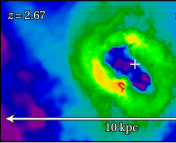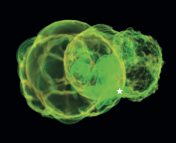PAPER: Long Gamma-Ray Transients from Collapsars
AUTHORS: Stan Woosley and Alex Heger
FIRST AUTHOR’S INSTITUTION: UC Santa Cruz
Today I have the great fun of writing about a paper that ties in closely with my current research. This paper discusses the possibility of low-energy, long-duration gamma-ray transients powered by “un-novae,” or failed supernovae. Full disclosure: my advisor is one of the authors.
First, some background. The “collapsar” referred to in the title of the paper is a model of a particular way a massive star can collapse at the end of its life; specifically, it’s a model of how a star can collapse to produce a gamma ray burst, a highly energetic beam of gamma rays that lasts a few seconds. The collapsar model posits that the star’s core is so dense that when it loses radiation support, not even degeneracy pressure can stop it from falling all the way down to a black hole. That black hole then sucks in the rest of the star’s mass, but the inner regions have sufficient angular momentum – they are spinning fast enough – to form an accretion disk, like water swirling as it goes down the drain in a bathtub. This disk then radiates some fraction of its immense gravitational potential energy in the form of a relativistic jet of matter beaming out of the star (the actual gamma rays are produced much later, in the jet itself).
But what if the inner layers were not rotating rapidly enough to form a disk? Indeed, we would expect this situation to be more common, since torques during the star’s pre-supernova evolution transfer angular momentum from the inner to the outer layers of the star. In this scenario, if the core collapsed straight down to a black hole (instead of forming a neutron star), the inner portions might follow right along without so much as a squeak. We usually assume that by that point those outer layers where the angular momentum was transferred have been ejected a long time ago by mass loss from strong winds that can push the outer envelope clean off a star, or else blown off by the outgoing shock during the collapse. But what if they remained, like a puddle left behind in our stellar bathtub?
That is the case that will concern us here: a collapse where the black hole inhales the star’s inner layer quietly, and the outer layer remains. A collapse in which a black hole forms without launching a shock to power a conventional supernova is known as an “un-nova,” since there would be little to no visible transient. However, if the un-nova occurred in a star that retained its outer, rapidly-spinning layer, that layer would fall back towards the black hole and form an accretion disk at a much later time. Unlike the traditional collapsar model, the material now falling in would do so over a much longer time ( seconds depending on the radius of the star, corresponding to the free-fall time of the outer envelope) and would produce much less energy. This accretion disk could power a long-duration, low-enegy gamma ray transient such as the one recently observed by SWIFT, Sw 1644+57.

Angular momentum vs. enclosed mass (right is farther out in radius)for a 24 solar mass star with very low metallicity (i.e. very little mass loss). The black line is the angular momentum distribution of the star, while the colored curves show the amount of angular momentum required to form a disk around a black hole. The inner portions of the star aren't spinning quickly enough, but the outer 9 solar masses could form a disk after a pause of a freefall time to allow them to collapse inwards.
The paper considers four scenarios for producing this case (a pre-supernova star with sufficient angular momentum in retained outer layers to form a disk at late times):
- low-metallicity stars with negligible mass loss,
- tidally locked supergiants,
- very massive stars collapsing via pair instability, and
- tidally locked helium stars.
In the low-metallicity case, the star has an unusually small content of metals (anything heavier than hydrogen or helium), making its outer layers more transparent and keeping them from being blown away by radiation pressure. These very low metallicity stars likely formed much earlier in the universe, when there were fewer metals around; because of those transparent outer layers, they did not undergo significant mass loss, and hence did not lose their rapidly spinning outer envelopes. In both cases of binary tidal locking (i.e. the supergiants or the helium stars), the presence of a companion enforces a particular spin rate in the outer layer, even if material is being lost; because the envelopes of the two stars are tidally locked together, they must rotate at the same rate that they orbit each other, meaning the companion essentially refreshes the angular momentum of the star. The pair instability case refers to a particular type of collapse in an extremely massive (think 300 solar masses) star. I won’t go in to the mechanisms of the collapse, but as in the low-metallicity case, the star does not lose enough mass to rid itself of sufficient angular momentum. The authors show that all four of these cases can produce a situation where the inner layers of the star collapse into the black hole but the rapidly spinning outer layer remains, and that when it falls in it has sufficient energy to power a long, low-energy gamma-ray transient.
Two major questions remain to be answered about this scenario: one, are the outer layers retained during the pre-supernova evolution; and two, does the black hole formation and inner collapse launch a shock. The outer layers of a massive star are only tenuously bound, and even the slightest hiccup during core collapse could launch a shock strong enough to puff away those rapidly rotating layers for good. In this case, the star would emit a faint optical transient instead.
If these transients can be modeled and detected, they could provide us with some key insights about the first generation of stars in particular, since these low-metallicity stars would be the least prone to mass loss and therefore the most likely to retain spinning outer layers. The authors perform a rough calculation assuming a transient duration of seconds and find that as many as 50 of these events could be active in the sky at any given time. Because of their low-energy, long-duration nature, the longer transients (puffed-up supergiants) might have already been observed and mistaken for blazars (blazing quasi-stellar objects), while the shorter transients (helium stars) may appear to be regular if slightly long gamma ray bursts (GRBs). As more transient surveys come online, all that’s certain is that the variable sky will only get weirder.




